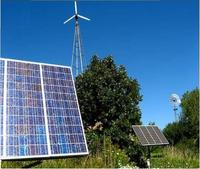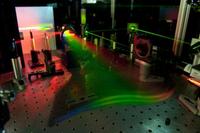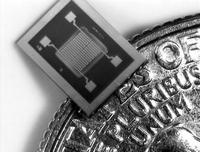-
Sewage treatment removes widely used home and garden insecticides from wastewater
Even though sewage treatment plants are not designed to remove tiny amounts of pesticides, they do an excellent job of dealing with the most widely used family of home and garden insecticides, scientists reported. The use of pyrethrins, derived from chrysanthemum flowers, and the related synthetic pyrethroids, has been on the increase during the last decade. Researchers found that advanced sewage treatment reduced the levels of pyrethroids by more than 97 percent.
-
-
Calculating the cost of a ton of mountaintop removal coal
To meet current U.S. coal demand through surface mining, an area of the Central Appalachians the size of Washington, D.C., would need to be mined every eighty-one days. This is about sixty-eight square miles — or roughly an area equal to ten city blocks mined every hour. A 1-year supply of coal would require converting about 310 square miles of the region’s mountains into surface mines.
-
-
Unified military intelligence picture dispels the fog of war
Military operations depend upon the unimpeded flow of accurate and relevant information to support timely decisions related to battle planning and execution. To address these needs, numerous intelligence systems and technologies have been developed over the past twenty years, but each of these typically provides only a partial picture of the battlefield, and integrating the information has proven to be burdensome and inefficient. DARPA’s Insight program aims to bring real-time, integrated, multi-source intelligence to the battlefield.
-
-
Beer-Sheva Cyber Security Park inaugurated by Prime Minister Benjamin Netanyahu
The development of the Negev took a step forward earlier this month with the inauguration of Beer-Sheva’s Advanced Technologies Park (ATP) in which Ben-Gurion University of the Negev (BGU) is the academic research partner. Israel prime minister Benjamin Netanyahu presided over the ribbon-cutting ceremony on 3 September.
-
-
Canada addresses environmental concerns over Keystone XL
Canadian prime minister Stephen Harper sent a letter to President Barack Obama last month offering to participate in joint efforts to reduce greenhouse-gas emissions in order to win approval of the Keystone XL Pipeline. Harper’s offer may allow Obama to approve the project without having to confront environmental groups.
-
-
Cold-formed steel rebuilds earthquake-resistant architecture
When engineers attempt to make a building earthquake-resistant, they use specific structural components, appropriately called details, to absorb earthquake forces and help direct some of those forces back to the ground. That works, but when an earthquake hits, the entire building reacts, not just the sections containing details. Even though academic research has led to improvements to the original building codes over the decades, there is much to be learned about the entire system of a cold-formed steel building as it responds to an earthquake.
-
-
Calculating the energy required to store wind and solar power on the grid

Renewable energy holds the promise of reducing carbon dioxide emissions. There are times, however, when solar and wind farms generate more electricity than is needed by consumers. Storing that surplus energy in batteries for later use seems like an obvious solution, but a new study from Stanford University suggests that might not always be the case.
-
-
New technique developed to assess the cost of major flood damage
A new approach to calculating the cost of damage caused by flooding was presented at the International Conference of Flood Resilience: Experiences in Asia and Europe which was held last week. The methodology combines information on land use with data on the vulnerability of the area to calculate the cost of both past and future flooding events.
-
-
Bomb-detecting lasers to improve security checkpoints

Research has put the possibility of bomb-detecting lasers at security checkpoints within reach by developing a laser that can detect micro traces of explosive chemicals on clothing and luggage. The laser not only detects the explosive material, but it also provides an image of the chemical’s exact location, even if it’s merely a minute trace on a zipper.
-
-
Researchers fabricate new camouflage coating from squid protein

What can the U.S. military learn from a common squid? A lot about how to hide from enemies, according to researchers. Researchers show that material that mimics calamari skin is invisible to infrared cameras, which is a good thing since infrared detection equipment is employed extensively by military forces for night vision, navigation, surveillance, and targeting.
-
-
“Climate Change, Water Conflicts, and Human Security” report released
Increasingly, climate change and the associated increase in the frequency of extreme weather events such as floods, droughts, and rising sea level, are acknowledged as not only having humanitarian impacts, but also creating national and regional political and security risks. While people and governments can adapt to these impacts, their capacity to do so varies.
-
-
Study links prehistoric climate shift to asteroid or comet impact
For the first time, a dramatic climate shift which has long fascinated scientists has been linked to the impact in Quebec of an asteroid or comet. The event took place about 12,900 years ago, at the beginning of the Younger Dryas period, and marks an abrupt global change to a colder, dryer climate, with far-reaching effects on both animals and humans.
-
-
Future of coal in Australia riskier than renewables
Coal-fired electricity may have little or no economic future in Australia, even if carbon capture and storage becomes commercially available, a new analysis has found. The study shows that coal with carbon capture and storage scenarios are likely to struggle to compete economically with 100 percent renewable electricity in a climate-constrained world, even if carbon capture and storage is commercialized by 2030.
-
-
Flexible vehicle-arrest system stops cars involved in crime, terrorism

Researchers have developed a mathematical model that could help engineers design a flexible vehicle-arrest system for stopping cars involved in criminal activity or terrorism, such as suspect car bombers attempting break through a check point, without wrecking the car or killing the occupants.
-
-
New detectors for chemical, biological threats

In the late 1990s, Sandia scientists developed a simple-to-use handheld chemical detector for the military, the MicroChemLab. Ever since, Sandia has improved such microfluidics- and microelectromechanical (MEMS) systems-based instruments that identify chemicals based on gas chromatography, or GC, and resonator-style instruments such as surface acoustic wave (SAW) detectors. The lab’s researchers are building on this sensor work to invent tiny detectors that can sniff out everything from explosives and biotoxins to smuggled humans.
-
More headlines
The long view
Autonomous Vehicle Technology Vulnerable to Road Object Spoofing and Vanishing Attacks
Researchers have demonstrated the potentially hazardous vulnerabilities associated with the technology called LiDAR, or Light Detection and Ranging, many autonomous vehicles use to navigate streets, roads and highways. The researchers have shown how to use lasers to fool LiDAR into “seeing” objects that are not present and missing those that are – deficiencies that can cause unwarranted and unsafe braking or collisions.
Tantalizing Method to Study Cyberdeterrence
Tantalus is unlike most war games because it is experimental instead of experiential — the immersive game differs by overlapping scientific rigor and quantitative assessment methods with the experimental sciences, and experimental war gaming provides insightful data for real-world cyberattacks.
Prototype Self-Service Screening System Unveiled
TSA and DHS S&T unveiled a prototype checkpoint technology, the self-service screening system, at Harry Reid International Airport (LAS) in Las Vegas, NV. The aim is to provide a near self-sufficient passenger screening process while enabling passengers to directly receive on-person alarm information and allow for the passenger self-resolution of those alarms.
Falling Space Debris: How High Is the Risk I'll Get Hit?
An International Space Station battery fell back to Earth and, luckily, splashed down harmlessly in the Atlantic. Should we have worried? Space debris reenters our atmosphere every week.
Testing Cutting-Edge Counter-Drone Technology
Drones have many positive applications, bad actors can use them for nefarious purposes. Two recent field demonstrations brought government, academia, and industry together to evaluate innovative counter-unmanned aircraft systems.
Strengthening the Grid’s ‘Backbone’ with Hydropower
Argonne-led studies investigate how hydropower could help add more clean energy to the grid, how it generates value as grids add more renewable energy, and how liner technology can improve hydropower efficiency.
